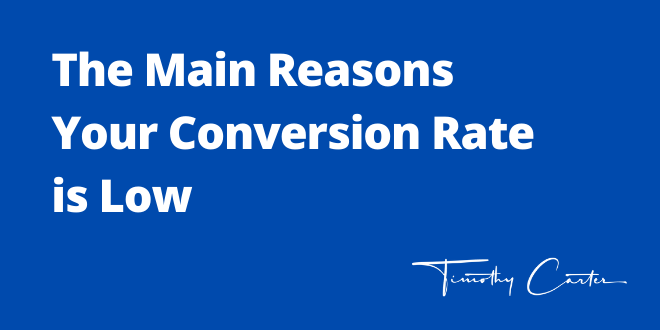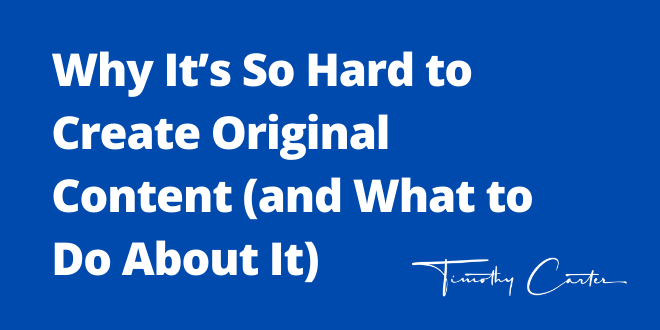
Can You Afford to Wait Months for an SEO Strategy to Develop?
June 24, 2023
Why Local Marketing is a Startup’s Best Friend
June 30, 2023How confident do you feel about your business’s conversion rate? Do you think you’re a high performer, getting more conversions than most of your competitors? Are you lagging behind? Or are you somewhere in the middle?
I have to assume you’re an average business since the average business is — well, average. And if that’s the case, I’m willing to bet that even if your conversion rate is higher than your peers’ conversion rates, it’s still not as high as it could be.
What’s a “Good” Conversion Rate, Anyway?
I want to start this discussion with a point about “good” conversion rates. You might have a “low” or “bad” conversion rate, but what does that really mean? At what point does a conversion rate go from “bad” to “good?” Is it at 3 percent? At 5 percent?

You can ballpark the overall “average” conversion rate at somewhere between 2 and 5 percent. But this statistic isn’t significant, because the average conversion rate changes considerably based on environmental factors.
For example:
- Industry. Different industries have different conversion rates. If you’re thinking about product sales, higher costs tend to be equated with lower conversion rates. This makes intuitive sense; more expensive products require more consideration and are more prone to things like procrastination and cart abandonment. So one industry’s outstanding conversion rate could be another industry’s lousy rate.
- Channel. You’ll also need to think about the channel you’re using, since conversions come in a variety of different contexts and functions. For example, the conversion rate you get with your PPC ads will not be equal to the conversion rate you get with email marketing – even if you’re running what is essentially the same content.
As you can see, there’s a lot of room for subjective analysis when it comes to averages and what counts as “good” or “bad.” Your conversion rate might seem nominally low, but it might be average to high compared to other businesses in your industry.
Conversely, you may feel like you have a high conversion rate – but it might be surprisingly low for your chosen channel.
Additionally, the average conversion rate for a given set of conditions doesn’t tell you much about what’s possible. For example, the average brand in a given market might see a 3 percent conversion rate, while top performers see 12 percent.
In that context, a 5 percent conversion rate would let you call yourself “above average,” but you’d still see fewer than half the conversions of a top-performing brand.
The Main Reasons Your Conversion Rate is Low
So, what factors are responsible for your conversion rate being, or remaining low?
Some of the reasons may be beyond your control. For example, your potential may be functionally capped if your industry or chosen channel has a naturally low conversion rate. So, how will you change that?
However, most marketers in most situations can get more control over their conversion rate by addressing the following problems:
- Audience targeting dissonance. Whether you’re using content marketing, PPC advertising, email marketing, or some other channel as your primary conversion generation engine, you’ll need to keep your audience in mind. You’re reaching a specific demographic, with specific perspectives and values; if your content isn’t relevant to them, or if it’s not persuasive to them, it’s going to fall flat.
- A weak offer. Most conversions offer some kind of exchange. For example, you’re offering a product in exchange for money, or you’re offering a PDF in exchange for personal information, or something similar. If the exchange isn’t seen as favorable, people won’t proceed. Juicing up the offer with freebies, extended discounts, or other bonuses can help you capture more people.
- A time-intensive process. Users tend to be impatient, no matter the demographic. If your conversion process takes too long, or if it’s too effort-intensive, people are going to abandon it part of the way through. You can streamline and simplify the process to capture more interest (and lose fewer people along the way).
- Unobvious calls to action (CTAs). I’m always surprised to see landing pages where the call to action (CTA) is not obvious. If you want to secure more conversions, you need a bright, borderline obnoxious button for people to conveniently click. Sometimes, something simple, like changing the color or moving it up in the design, is all it takes to win more conversions.
- Lack of information. In most situations, people want ample information before volunteering their personal information or hard-earned money. If it’s not clear what the benefits are, or if people are confused about what your offer is, they’re not going to take action. Including a more robust list of benefits or linking to other informative resources can help you here.
- Low trust. People need to trust you before they’re willing to convert. If you’re a new brand, or if people aren’t familiar with your products, this will be a big issue. Fortunately, you can compensate for this by including more trust signals – such as offering customer reviews and testimonials or showing off major partnerships you’ve managed to secure.
The Importance of Testing for Conversion Rate
If you want to be successful with conversion optimization, testing is crucial. You need a lot of experiments and a lot of data to master this art.
Experiments are a great way to try out new angles, new designs, and new copy. Over time, through AB testing, you’ll figure out which techniques are effective in securing new conversions – and which ones fall flat. It’s also a way to prove your hypotheses and theories; just because you think something will boost your conversion rate doesn’t mean it’s going to.
Similarly, it’s important to run tests with live users – and use surveys to gather data on their perspectives throughout the process. For example, if you’re finding that most users aren’t interested in making a purchase, despite fitting your target customer persona, try to figure out what’s stopping them. Is the price too high? Are they untrusting?
There’s almost always room for growth when it comes to boosting conversion rates, so you need to adopt a mindset of continuous, iterative improvement. Keep trying new things and playing with new tools to see if you can make progress — or breakthrough your latest plateau.
Beyond Conversions
Optimizing for conversions and securing a higher conversion rate is going to be crazy good for your business.
Yes, optimizing for conversions and securing that higher conversion rate IS going to be fantastic — but it’s not the only thing you’ll need to consider if you want to be successful across your marketing and advertising strategies.
For example:
- Spending, ROI, and profitability. You’ll need to think about your spending level, your return on investment (ROI), and your overall profitability. For example, it doesn’t cost anything to make an organic post on social media, but it could cost hundreds to thousands of dollars for single ad placement on a sufficiently trafficked channel. A high conversion rate on a super expensive channel, therefore, isn’t as valuable as a decent conversion rate on a cheap channel.
- Traffic flow. Your conversion rate will be modified by the flow of traffic on your channel of choice; if your 5 percent conversion rate is consistent, it’s much better to have 10,000 visitors than 1,000 visitors. Once you have a solid conversion strategy in place, you can work on increasing your traffic.
- Reputation and user experience. Also, keep in mind the user experience you’re providing and your reputation as a brand. You might be able to milk some extra conversions with spammy tactics and aggressive marketing, but if it’s detrimental to your reputation, it won’t be worth it.
Your conversion rate isn’t everything. But it’s going to have a significant impact on your marketing outcomes, for better or for worse. This relatively short article doesn’t have everything you’ll need to master the art of conversion rate optimization. Still, it should get you started in the right direction – and help you understand that, yes, it’s possible to push your conversion rate much higher.
Image Credit: anthony shkraba; pexels; thank you!






